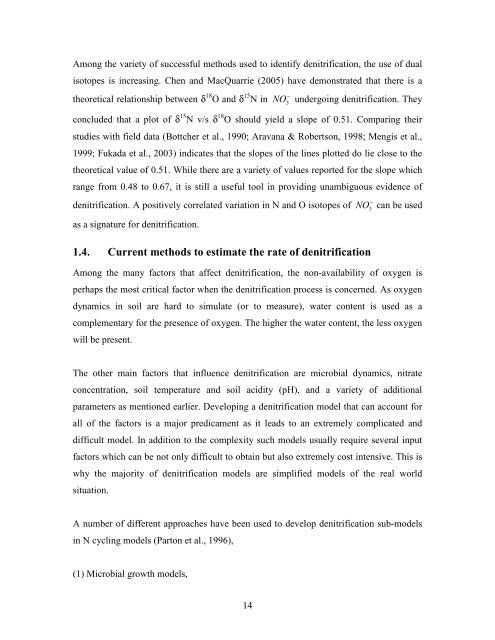THE FLORIDA STATE UNIVERSITY ARTS AND SCIENCES ...
THE FLORIDA STATE UNIVERSITY ARTS AND SCIENCES ...
THE FLORIDA STATE UNIVERSITY ARTS AND SCIENCES ...
Create successful ePaper yourself
Turn your PDF publications into a flip-book with our unique Google optimized e-Paper software.
Among the variety of successful methods used to identify denitrification, the use of dual<br />
isotopes is increasing. Chen and MacQuarrie (2005) have demonstrated that there is a<br />
theoretical relationship between δ 18 O and δ 15 N in<br />
14<br />
−<br />
NO 3 undergoing denitrification. They<br />
concluded that a plot of δ 15 N v/s δ 18 O should yield a slope of 0.51. Comparing their<br />
studies with field data (Bottcher et al., 1990; Aravana & Robertson, 1998; Mengis et al.,<br />
1999; Fukada et al., 2003) indicates that the slopes of the lines plotted do lie close to the<br />
theoretical value of 0.51. While there are a variety of values reported for the slope which<br />
range from 0.48 to 0.67, it is still a useful tool in providing unambiguous evidence of<br />
denitrification. A positively correlated variation in N and O isotopes of<br />
as a signature for denitrification.<br />
1.4. Current methods to estimate the rate of denitrification<br />
−<br />
NO 3 can be used<br />
Among the many factors that affect denitrification, the non-availability of oxygen is<br />
perhaps the most critical factor when the denitrification process is concerned. As oxygen<br />
dynamics in soil are hard to simulate (or to measure), water content is used as a<br />
complementary for the presence of oxygen. The higher the water content, the less oxygen<br />
will be present.<br />
The other main factors that influence denitrification are microbial dynamics, nitrate<br />
concentration, soil temperature and soil acidity (pH), and a variety of additional<br />
parameters as mentioned earlier. Developing a denitrification model that can account for<br />
all of the factors is a major predicament as it leads to an extremely complicated and<br />
difficult model. In addition to the complexity such models usually require several input<br />
factors which can be not only difficult to obtain but also extremely cost intensive. This is<br />
why the majority of denitrification models are simplified models of the real world<br />
situation.<br />
A number of different approaches have been used to develop denitrification sub-models<br />
in N cycling models (Parton et al., 1996),<br />
(1) Microbial growth models,
















